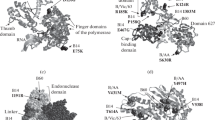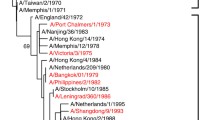Abstract
Mutations in viral proteins can lead to the cold adaption of influenza A virus and the cold-adapted virus is an important vaccination instrument. Here, we identify a novel strain of influenza A virus with cold sensitivity conferred by a mutation at a phosphorylation site within the nucleoprotein (NP). The highly conserved tyrosine 385 residue (Y385) of NP was identified as a phosphorylation site by mass spectrometry. The constructive NP phosphorylation mimicked by Y385E mutation was fatal for virus replication, while the continuous Y385 dephosphorylation mimicked by Y385F mutation had little impact on virus replication in vitro. Notably, the Y385F virus showed much lower replicative capacity in turbinates of mice compared with the wild type virus. Moreover, the replication of Y385F virus was significantly reduced in both A549 and MDCK cells grown at 33°C, when compared to that at 37°C. These results indicated that the Y385F mutation led to cold sensitivity of virus. We further found that the cold sensitivity of Y385F virus could be attributed to diminished NP oligomerization rather than any changes in intracellular localization. Taken together, these findings suggest that the phosphorylation of NP may be a critical factor that regulates the temperature sensitivity of influenza A virus.
Similar content being viewed by others
References
Alford, R.H., Kasel, J.A., Gerone, P.J., and Knight, V. (1966). Human influenza resulting from aerosol inhalation. Exp Biol Med 122, 800–804.
Arranz, R., Coloma, R., Chichón, F.J., Conesa, J.J., Carrascosa, J.L., Valpuesta, J.M., Ortín, J., and Martín-Benito, J. (2012). The structure of native influenza virion ribonucleoproteins. Science 338, 1634–1637.
Chan, W., Zhou, H., Kemble, G., and Jin, H. (2008). The cold adapted and temperature sensitive influenza A/Ann Arbor/6/60 virus, the master donor virus for live attenuated influenza vaccines, has multiple defects in replication at the restrictive temperature. Virology 380, 304–311.
Chan, W.H., Ng, A.K.L., Robb, N.C., Lam, M.K.H., Chan, P.K.S., Au, S.W. N., Wang, J.H., Fodor, E., and Shaw, P.C. (2010). Functional analysis of the influenza virus H5N1 nucleoprotein tail loop reveals amino acids that are crucial for oligomerization and ribonucleoprotein activities. J Virol 84, 7337–7345.
Chursov, A., Kopetzky, S.J., Leshchiner, I., Kondofersky, I., Theis, F.J., Frishman, D., and Shneider, A. (2012). Specific temperature-induced perturbations of secondary mRNA structures are associated with the cold-adapted temperature-sensitive phenotype of influenza A virus. RNA Biol 9, 1266–1274.
Coloma, R., Valpuesta, J.M., Arranz, R., Carrascosa, J.L., Ortín, J., and Martín-Benito, J. (2009). The structure of a biologically active influenza virus ribonucleoprotein complex. PLoS Pathog 5, e1000491.
Cox, A., Baker, S.F., Nogales, A., Martínez-Sobrido, L., and Dewhurst, S. (2015). Development of a mouse-adapted live attenuated influenza virus that permits in vivo analysis of enhancements to the safety of live attenuated influenza virus vaccine. J Virol 89, 3421–3426.
Cox, N.J., Kitame, F., Kendal, A.P., Maassab, H.F., and Naeve, C. (1988). Identification of sequence changes in the cold-adapted, live attenuated influenza vaccine strain, A/Ann Arbor/6/60 (H2N2). Virology 167, 554–567.
Cui, L., Zheng, W., Li, M., Bai, X., Yang, W., Li, J., Fan, W., Gao, G.F., Sun, L., and Liu, W. (2019). Phosphorylation status of tyrosine 78 residue regulates the nuclear export and ubiquitination of influenza A virus nucleoprotein. Front Microbiol 10.
Dalton, R.M., Mullin, A.E., Amorim, M.J., Medcalf, E., Tiley, L.S., and Digard, P. (2006). Temperature sensitive influenza A virus genome replication results from low thermal stability of polymerase-cRNA complexes. Virol J 3, 58.
Elton, D., Medcalf, E., Bishop, K., and Digard, P. (1999). Oligomerization of the influenza virus nucleoprotein: Identification of positive and negative sequence elements. Virology 260, 190–200.
Hutchinson, E.C., Denham, E.M., Thomas, B., Trudgian, D.C., Hester, S.S., Ridlova, G., York, A., Turrell, L., and Fodor, E. (2012). Mapping the phosphoproteome of influenza A and B viruses by mass spectrometry. PLoS Pathog 8, e1002993.
Jin, H., Lu, B., Zhou, H., Ma, C., Zhao, J., Yang, C., Kemble, G., and Greenberg, H. (2003). Multiple amino acid residues confer temperature sensitivity to human influenza virus vaccine strains (FluMist) derived from cold-adapted A/Ann Arbor/6/60. Virology 306, 18–24
Klimov, A.I., Cox, N.J., Yotov, W.V., Rocha, E., Alexandrova, G.I., and Kendal, A.P. (1992). Sequence changes in the live attenuated, cold-adapted variants of influenza A/Leningrad/134/57 (H2N2) virus. Virology 186, 795–797.
Lamb, R.A., and Choppin, P.W. (1983). The gene structure and replication of influenza virus. Annu Rev Biochem 52, 467–506.
Lee, K.H., Seo, S.U., Song, J.M., Lee, C.M., Kim, H.A., and Seong, B.L. (2006). Characterization of live influenza vaccine donor strain derived from cold-adaptation of X-31 virus. Vaccine 24, 1966–1974.
Li, Y., Sun, L., Zheng, W., Madina Mahesutihan, W., Li, J., Bi, Y., Wang, H., Liu, W., and Luo, T.R. (2018). Phosphorylation and dephosphorylation of threonine 188 in nucleoprotein is crucial for the replication of influenza A virus. Virology 520, 30–38.
Li, Z., Watanabe, T., Hatta, M., Watanabe, S., Nanbo, A., Ozawa, M., Kakugawa, S., Shimojima, M., Yamada, S., Neumann, G., et al. (2009). Mutational analysis of conserved amino acids in the influenza A virus nucleoprotein. J Virol 83, 4153–4162.
Liu, X., Sun, L., Yu, M., Wang, Z., Xu, C., Xue, Q., Zhang, K., Ye, X., Kitamura, Y., and Liu, W. (2009). Cyclophilin A interacts with influenza A virus M1 protein and impairs the early stage of the viral replication. Cell Microbiol 11, 730–741.
Marklund, J.K., Ye, Q., Dong, J., Tao, Y.J., and Krug, R.M. (2012). Sequence in the influenza A virus nucleoprotein required for viral polymerase binding and RNA synthesis. J Virol 86, 7292–7297.
Martínez-Sobrido, L., Peersen, O., and Nogales, A. (2018). Temperature sensitive mutations in influenza A viral ribonucleoprotein complex responsible for the attenuation of the live attenuated influenza vaccine. Viruses 10, 560.
Mondal, A., Potts, G.K., Dawson, A.R., Coon, J.J., and Mehle, A. (2015). Phosphorylation at the homotypic interface regulates nucleoprotein oligomerization and assembly of the influenza virus replication machinery. PLoS Pathog 11, e1004826.
Neumann, G., Castrucci, M.R., and Kawaoka, Y. (1997). Nuclear import and export of influenza virus nucleoprotein. J Virol 71, 9690–9700.
Nogales, A., Rodriguez, L., Chauché, C., Huang, K., Reilly, E.C., Topham, D.J., Murcia, P.R., Parrish, C.R., and Martínez-Sobrido, L. (2017a). Temperature-sensitive live-attenuated canine influenza virus H3N8 vaccine. J Virol 91.
Nogales, A., Rodriguez, L., DeDiego, M.L., Topham, D.J., and Martínez-Sobrido, L. (2017b). Interplay of PA-X and NS1 proteins in replication and pathogenesis of a temperature-sensitive 2009 pandemic H1N1 influenza A virus. J Virol 91.
Noton, S.L., Simpson-Holley, M., Medcalf, E., Wise, H.M., Hutchinson, E. C., McCauley, J.W., and Digard, P. (2009). Studies of an influenza A virus temperature-sensitive mutant identify a late role for NP in the formation of infectious virions. J Virol 83, 562–571.
Ozawa, M., Fujii, K., Muramoto, Y., Yamada, S., Yamayoshi, S., Takada, A., Goto, H., Horimoto, T., and Kawaoka, Y. (2007). Contributions of two nuclear localization signals of influenza A virus nucleoprotein to viral replication. J Virol 81, 30–41.
Rodriguez, L., Reedy, S., Nogales, A., Murcia, P.R., Chambers, T.M., and Martinez-Sobrido, L. (2018). Development of a novel equine influenza virus live-attenuated vaccine. Virology 516, 76–85.
Ruigrok, R.W.H., and Baudin, F. (1995). Structure of influenza virus ribonucleoprotein particles. II. Purified RNA-free influenza virus ribonucleoprotein forms structures that are indistinguishable from the intact influenza virus ribonucleoprotein particles. J Gen Virol 76, 1009–1014.
Snyder, M.H., Clements, M.L., De Borde, D., Maassab, H.F., and Murphy, B.R. (1985). Attenuation of wild-type human influenza A virus by acquisition of the PA polymerase and matrix protein genes of influenza A/Ann Arbor/6/60 cold-adapted donor virus. J Clin Microbiol 22, 719–725.
Subbarao, E.K., Kawaoka, Y., and Murphy, B.R. (1993). Rescue of an influenza A virus wild-type PB2 gene and a mutant derivative bearing a site-specific temperature-sensitive and attenuating mutation. J Virol 67, 7223–7228.
Tsybalova, L.M., Gorev, N.E., Potapchuk, M.V., Repko, I.A., Korotkov, A. V., Sergeeva, M.V., Komissarov, A.B., Pisareva, M.M., Kuznetsov, V.V., Grudinin, M.P., et al. (2012). Characterization of cold-adapted influenza strain A/HongKong/1/68/162/35 as a potential donor of attenuation and high reproduction (in Russian). Voprosy virusologii 57, 13–17.
Turrell, L., Hutchinson, E.C., Vreede, F.T., and Fodor, E. (2015). Regulation of influenza A virus nucleoprotein oligomerization by phosphorylation. J Virol 89, 1452–1455.
Wang, S., Zhao, Z., Bi, Y., Sun, L., Liu, X., and Liu, W. (2013). Tyrosine 132 Phosphorylation of Influenza A Virus M1 Protein Is Crucial for Virus Replication by Controlling the Nuclear Import of M1. J Virol 87, 6182–6191.
Wareing, M.D., and Tannock, G.A. (2001). Live attenuated vaccines against influenza; an historical review. Vaccine 19, 3320–3330.
Webster, R.G., Yakhno, M., Hinshaw, V.S., Bean, W.J., and Copal Murti, K. (1978). Intestinal influenza: replication and characterization of influenza viruses in ducks. Virology 84, 268–278.
Ye, Q., Krug, R.M., and Tao, Y.J. (2006). The mechanism by which influenza A virus nucleoprotein forms oligomers and binds RNA. Nature 444, 1078–1082.
Youil, R., Kiseleva, I., Kwan, W.S., Szymkowiak, C., Toner, T.J., Su, Q., Klimov, A., Rudenko, L., and Shaw, A.R. (2004). Phenotypic and genetic analyses of the heterogeneous population present in the cold-adapted master donor strain: A/Leningrad/134/17/57 (H2N2). Virus Res 102, 165–176.
Zheng, W., Li, J., Wang, S., Cao, S., Jiang, J., Chen, C., Ding, C., Qin, C., Ye, X., Gao, G.F., et al. (2015). Phosphorylation controls the nuclearcytoplasmic shuttling of influenza A virus nucleoprotein. J Virol 89, 5822–5834.
Acknowledgements
This work was supported by grants from the Strategic Priority Research Program of Chinese Academy of Sciences (XDB29010000), the National Natural Science Foundation of China (31630079, 31972657, and 31672531), the National Key Research and Development Program of China (2016YFD0500206), and the Mega-Project of Guangxi Natural Science Foundation (2015GXNSFEA139002). Jing Li is supported by Youth Innovation Promotion Association of CAS (2019091).
Author information
Authors and Affiliations
Corresponding author
Additional information
Compliance and ethics
The authors declare that the research was conducted in the absence of any commercial or financial relationships that could be construed as a potential conflict of interest.
Rights and permissions
About this article
Cite this article
Zheng, W., Cui, L., Li, M. et al. Nucleoprotein phosphorylation site (Y385) mutation confers temperature sensitivity to influenza A virus due to impaired nucleoprotein oligomerization at a lower temperature. Sci. China Life Sci. 64, 633–643 (2021). https://doi.org/10.1007/s11427-020-1727-y
Received:
Accepted:
Published:
Issue Date:
DOI: https://doi.org/10.1007/s11427-020-1727-y




